
The Porta San Frediano was the westernmost gate in the 13th-century walls of the Oltrarno section of Florence, region of Tuscany, Italy. It is located where Borgo San Frediano becomes Via Pisana. This was the access gate to the road to Pisa.

The Porta San Frediano was the westernmost gate in the 13th-century walls of the Oltrarno section of Florence, region of Tuscany, Italy. It is located where Borgo San Frediano becomes Via Pisana. This was the access gate to the road to Pisa.
This ancient gate is attributed to the architect Andrea Pisano, and is named after the nearby church of San Frediano, which was rebuilt as the church of San Frediano in Cestello. The gate was finished in 1332. In 1363 the Blessed Paola of the Monastery of the Angioli had a vision of Saint John the Baptist blessing Florence. This vision was interpreted as a premonition that the Florentines would defeat the Pisan army at the Battle of Cascina. [1]
Through this gate, King Charles VIII of France entered Florence. [2] A depiction of the gate in c. 1494 can be seen in a painting by Filippino Lippi, namely the Madonna and Child with Saint John among Saints Martin of Tours and Catherine of Alexandria found in the Nerli Chapel of the church of Santo Spirito, Florence. [3] The gate still has its large wooden and metal doors.
Coordinates: 43°46′13.68″N11°14′24.02″E / 43.7704667°N 11.2400056°E

Lucca is a city and comune in Tuscany, Central Italy, on the Serchio River, in a fertile plain near the Ligurian Sea. The city has a population of about 89,000, while its province has a population of 383,957.
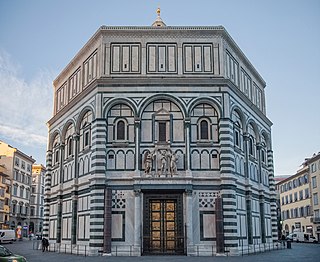
The Florence Baptistery, also known as the Baptistery of Saint John, is a religious building in Florence, Italy, and has the status of a minor basilica. The octagonal baptistery stands in both the Piazza del Duomo and the Piazza San Giovanni, across from Florence Cathedral and the Campanile di Giotto.

The province of Lucca is a province in the Tuscany region of Italy. Its capital is the city of Lucca.

The Basilica of San Frediano is a Romanesque church in Lucca, Italy, situated on the Piazza San Frediano.

Domenico Passignano, born DomenicoCresti or Crespi, was an Italian painter of a late-Renaissance or Counter-Maniera (Counter-Mannerism) style that emerged in Florence towards the end of the 16th century.

Santo Stefano al Ponte is a Romanesque-style, Roman Catholic church, located in the Piazza of the same name, just off the Via Por Santa Maria, near the Ponte Vecchio, in Florence, region of Tuscany, Italy. The church is presently used as a concert hall.

Cascina is a comune (municipality) in the Province of Pisa in the Italian region Tuscany, located about 60 kilometres (37 mi) west of Florence and about 13 kilometres (8 mi) southeast of Pisa.

The Oltrarno is a quarter of Florence, Italy. The name means beyond the Arno ; it is located south of the River Arno. It contains part of the historic centre of Florence and many notable sites such as the church Santo Spirito di Firenze, Palazzo Pitti, Belvedere, and Piazzale Michelangelo.

Aurelio Lomi was an Italian painter of the late-Renaissance and early-Baroque periods, active mainly in his native town of Pisa, Tuscany.

Santa Maria Maddalena dei Pazzi is a Renaissance-style Roman Catholic church and a former convent located in Borgo Pinti in central Florence.

San Frediano in Cestello is a Baroque-style, Roman Catholic church in the Oltrarno section of Florence, region of Tuscany, Italy. The name cestello derives from the Cistercians who occupied the church in 1628. Previously the site had a 1450s church attached to the cloistered Carmelite convent of Santa Maria degli Angeli.
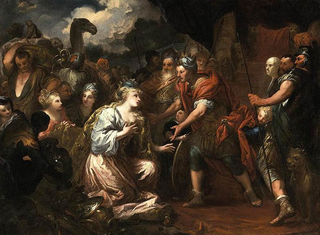
Pietro Dandini was an Italian painter of the Baroque period, active mainly in Florence.
San Frediano is the name of an early Christian Irish pilgrim, who became bishop of Lucca, Tuscany, Italy. Named after him are:

The Madonna with St. Catherine of Alexandria and St. Martin of Tours is a painting by the Italian Renaissance painter Filippino Lippi created c. 1485–1488. It is housed in the church of Santo Spirito of Florence. St. John the Baptist, the patron saint of Florence, appears on the right hand side of the Virgin. The infant Christ turns towards his precursor also a juvenile, dressed in animal skins as appropriate for a desert saint and whose staff has a crossbar referring to the Crucifixion to come.
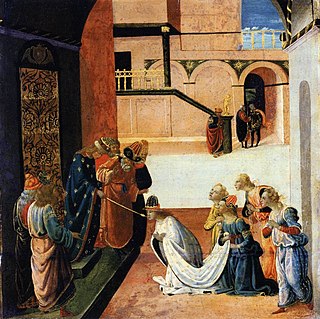
Jacopo del Sellaio (1441/2–1493), was an Italian painter of the early Renaissance, active in his native Florence. His real name was Jacopo di Arcangelo. He worked in an eclectic style based on those of Botticelli, Filippino Lippi, and Domenico Ghirlandaio. The nickname Sellaio derives from the profession of his father, a saddle maker.

Saint Fridianus, was an Irish prince and hermit, fl. 6th century. Tradition names him as a son of King Ultach of Ulster. He later migrated to Italy, where he was appointed as Bishop of Lucca. The Basilica of San Frediano in the city is dedicated to him, as are churches in Florence.
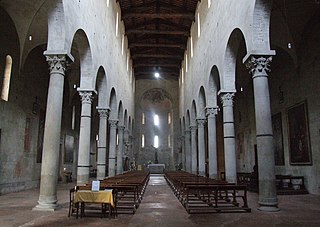
San Bartolomeo in Pantano is a Romanesque and Gothic style, Roman Catholic church in Pistoia, Tuscany, central Italy, dedicated to St. Bartholomew the Apostle. The pantano of the name refers to the once marshy area in which the building was located.

The Porta Romana, once known as the Porta San Pier Gattolino was the southernmost gate in the 13th-century walls of the Oltrarno section of Florence, region of Tuscany, Italy. It stands at the confluence of a number of roads: accessed from north by Via Romana, Via de' Serragli, and Viale Francesco Petrarca. In addition, a central road along the Boboli Gardens begins near the gate, and allowed the inhabitants of the Pitti Palace to exit and enter Florence with minimal travel on city streets. Beyond the gates are the Via del Poggio Imperiale and Via Senese. The latter led to Siena and points south such as Rome, hence the name. When the majority of the defensive walls of Florence were razed in the 19th century, only a few, and sometimes partial gate structures were left standing including Porta San Gallo, Tower of San Niccolò, and this gate with a snippet of merlonated wall.
Antonio Montauti was an 18th-century Italian sculptor active in Florence and Rome.
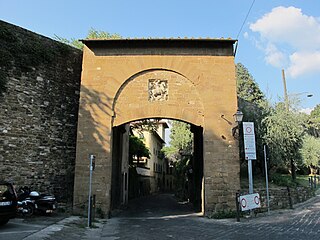
The Porta San Giorgio is a medieval gateway located on the south-east end of the Oltrarno walls of Florence, Italy. Ramparts of the Belvedere fortress, begun in 1590, stand adjacent to the gate. The road away from Florence soon passes the church of San Leonardo in Arcetri.